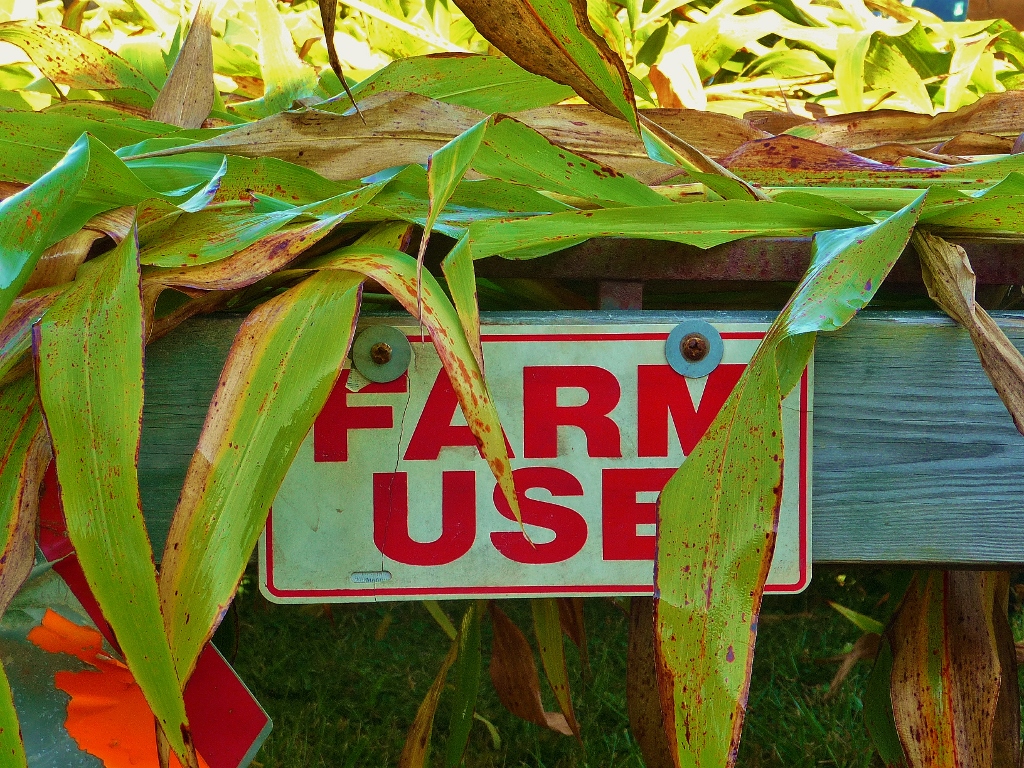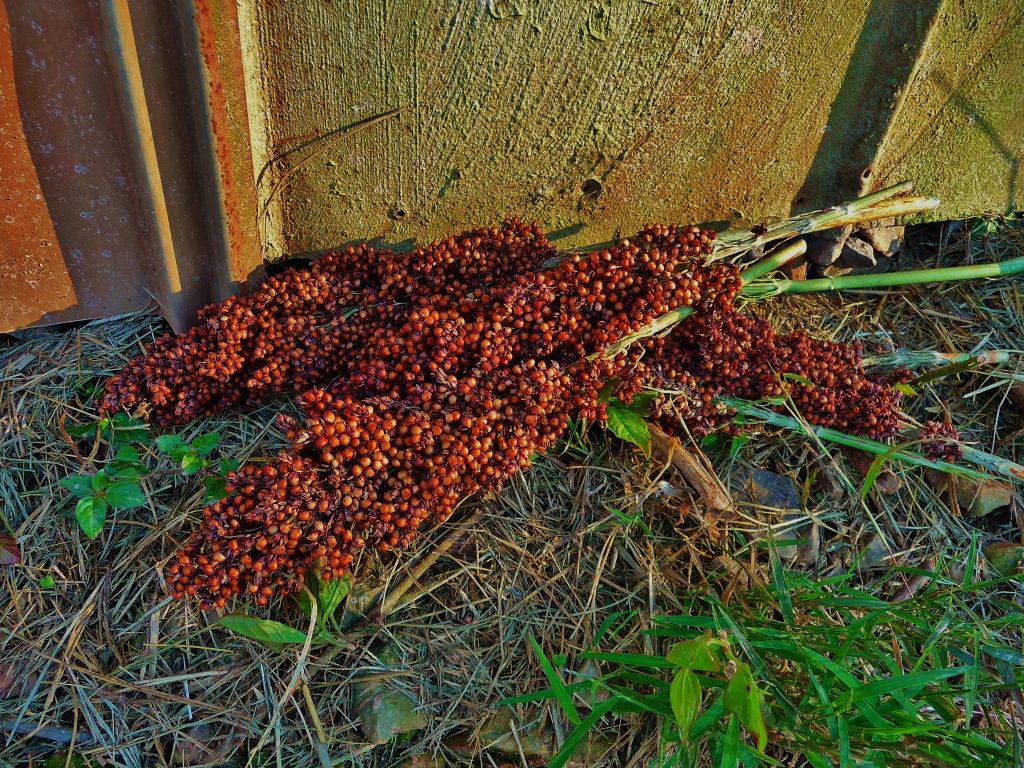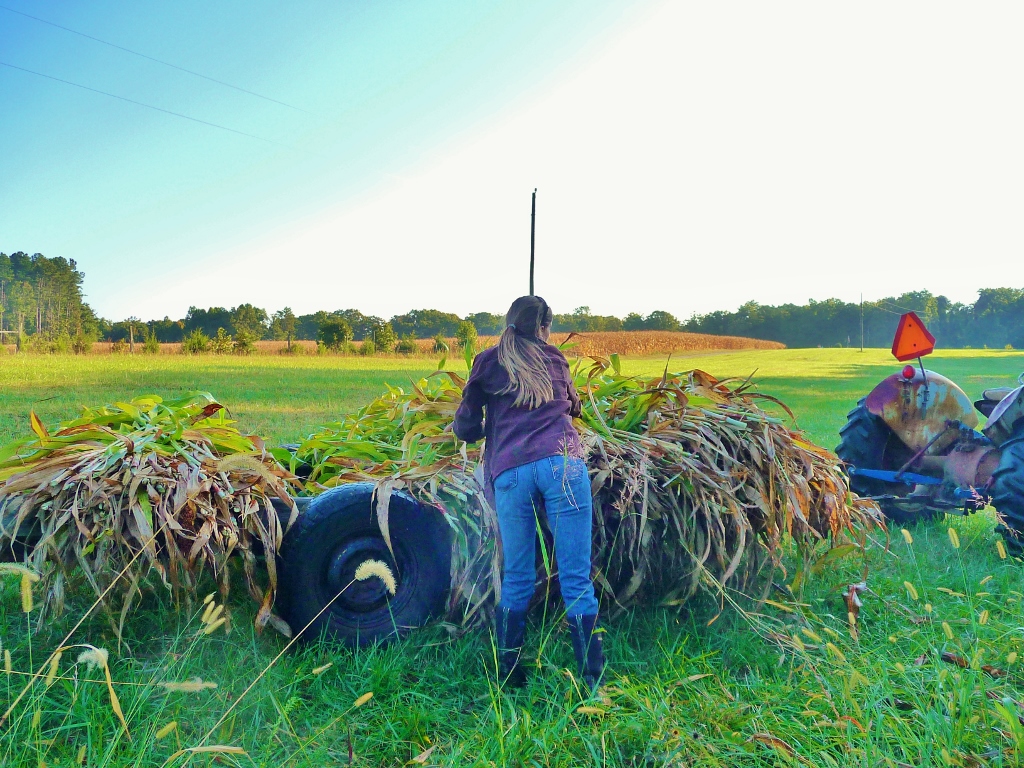 Molasses-making has become a rare art, but a few Virginians still carry on the old homesteading practice using sorghum, a plant that came from Africa and is used in various forms for grain, biofuel, and silage. The molasses that shows up on store shelves is made from sugar canes or sugar beets, and technically the thick, sweet product created from the sorghum plant is “sorghum syrup.” However, the traditional title of “sorghum molasses” still stands amongst many producers and the two names are sometimes used interchangeably. “Sweet sorghum” is the moniker used to categorize the unique varieties chosen for molasses-making that have more stalk juice and sugars than the forage or grain sorghum varieties do.
Molasses-making has become a rare art, but a few Virginians still carry on the old homesteading practice using sorghum, a plant that came from Africa and is used in various forms for grain, biofuel, and silage. The molasses that shows up on store shelves is made from sugar canes or sugar beets, and technically the thick, sweet product created from the sorghum plant is “sorghum syrup.” However, the traditional title of “sorghum molasses” still stands amongst many producers and the two names are sometimes used interchangeably. “Sweet sorghum” is the moniker used to categorize the unique varieties chosen for molasses-making that have more stalk juice and sugars than the forage or grain sorghum varieties do.
Sorghum looks similar to corn when it begins to grow. Sweet sorghum varieties grow particularly tall. The plants develop heads containing seeds, which are cut off prior to harvest so that the stalk juices remain high in sugar. Sugar content in the stalks drops as the seed heads become more and more mature. Some seed heads are saved for the next years’ crop. Seed-saving is important because certain sweet sorghum seeds have become rather rare and some growers have to cross state lines to seek out particular varieties.
 Once the stalks have grown up and the plant is mature enough to cut, the molasses-making crowd must assemble. Molasses-making tends to be a community affair, after all, and the more hands to cut, haul, carry, and stir the molasses, the better. The harvest must take place before a fall frost hits because sorghum, like corn, is a summer crop that does not tolerate cold weather. This year, Don and Betty Bowman of central Virginia invited friends and neighbors to their sorghum harvest as they have done for many years in the past. There is usually so much sorghum to cut that the family gets started in the field the evening before molasses-making day, and this year was no exception. The next day, volunteers finish cutting down the last of the stalks and loading them onto a wagon that carries them to the mill site. An early start is key because the sorghum takes nearly all day to complete. The 2013 effort was already in full swing by 8:00 AM on molasses day.
Once the stalks have grown up and the plant is mature enough to cut, the molasses-making crowd must assemble. Molasses-making tends to be a community affair, after all, and the more hands to cut, haul, carry, and stir the molasses, the better. The harvest must take place before a fall frost hits because sorghum, like corn, is a summer crop that does not tolerate cold weather. This year, Don and Betty Bowman of central Virginia invited friends and neighbors to their sorghum harvest as they have done for many years in the past. There is usually so much sorghum to cut that the family gets started in the field the evening before molasses-making day, and this year was no exception. The next day, volunteers finish cutting down the last of the stalks and loading them onto a wagon that carries them to the mill site. An early start is key because the sorghum takes nearly all day to complete. The 2013 effort was already in full swing by 8:00 AM on molasses day.
 Once the wagonloads of sorghum are driven back to the molasses-making site, the extraction process begins. In the past, the Bowmans fed the stalks into a horse-drawn mill, and then they made a technological leap by powering the mill with a lawn tractor. Mrs. Bowman humorously recalls having to sit on the ground to feed stalks into the mill while it was running so that it would not hit her in the head each time it circled around. According to Mrs. Bowman, this method still required upwards of three hours to complete, so the family came up with an even better solution and began to power their mill with a belt running off a stationary tractor.
Once the wagonloads of sorghum are driven back to the molasses-making site, the extraction process begins. In the past, the Bowmans fed the stalks into a horse-drawn mill, and then they made a technological leap by powering the mill with a lawn tractor. Mrs. Bowman humorously recalls having to sit on the ground to feed stalks into the mill while it was running so that it would not hit her in the head each time it circled around. According to Mrs. Bowman, this method still required upwards of three hours to complete, so the family came up with an even better solution and began to power their mill with a belt running off a stationary tractor.
 As the canes are crushed in the rollers, juice is screened and collected into a bucket which connects to a tube that transports the juice downhill to the vat station. Here, the juice does not immediately enter the vat. First, it travels through another series of screens that prevent fibers and plant particles from staying in the juice as it fills the vat. The vat that the Bowmans use is a batch-type system that cooks one large pan of juice at once. Some producers use a “continuous flow” system that gradually creates molasses as juice travels through a series of compartments.
As the canes are crushed in the rollers, juice is screened and collected into a bucket which connects to a tube that transports the juice downhill to the vat station. Here, the juice does not immediately enter the vat. First, it travels through another series of screens that prevent fibers and plant particles from staying in the juice as it fills the vat. The vat that the Bowmans use is a batch-type system that cooks one large pan of juice at once. Some producers use a “continuous flow” system that gradually creates molasses as juice travels through a series of compartments. 

 Boiling does not begin until all the stalks have been fed through the mill and extraction is complete. The vat is set over a fire pit that is lit and monitored closely to ensure that the temperatures are appropriate. Volunteers keep the fire hot so that the juice will begin to boil. At this time, someone must stir the vat and agitate the bottom so that the sorghum does not burn. Once the juice reaches a full boil, people take turns skimming proteins and coagulated components off the top surface of the juice. If the fire gets too hot, the juice boils too high and overflows.
Boiling does not begin until all the stalks have been fed through the mill and extraction is complete. The vat is set over a fire pit that is lit and monitored closely to ensure that the temperatures are appropriate. Volunteers keep the fire hot so that the juice will begin to boil. At this time, someone must stir the vat and agitate the bottom so that the sorghum does not burn. Once the juice reaches a full boil, people take turns skimming proteins and coagulated components off the top surface of the juice. If the fire gets too hot, the juice boils too high and overflows.
 The boiling and skimming step is the longest part of the process. It can take nearly all day, and sometimes can last into the night. The fire continues to keep the vat boiling which kills bacteria and cooks more and more water out of the juice. When the sorghum nears the right temperature and density, the fire is cut back and the final skimming continues. The Bowmans have found that overcooking or undercooking leads to a lower-quality product, so they occasionally put their finished product back on the fire pit for more boiling or they add water and reboil the vat to thin molasses that has gotten too thick. The finished vat cools a bit, and then the Bowmans transfer the molasses to a metal tank with a shutoff valve that allows them to bottle it more easily.
The boiling and skimming step is the longest part of the process. It can take nearly all day, and sometimes can last into the night. The fire continues to keep the vat boiling which kills bacteria and cooks more and more water out of the juice. When the sorghum nears the right temperature and density, the fire is cut back and the final skimming continues. The Bowmans have found that overcooking or undercooking leads to a lower-quality product, so they occasionally put their finished product back on the fire pit for more boiling or they add water and reboil the vat to thin molasses that has gotten too thick. The finished vat cools a bit, and then the Bowmans transfer the molasses to a metal tank with a shutoff valve that allows them to bottle it more easily.
This year’s quarter-acre sorghum plot yielded about nine gallons of finished molasses. Typically it takes 6-12 gallons of raw juice to cook into one gallon of sorghum molasses. What happens to the crushed, discarded sorghum plant material? The Bowmans let their cattle access the pile, and the cows eat the stalks with enthusiasm.
 Finished sorghum molasses has a golden-brown hue and is enjoyed as a sweetener on biscuits and desserts. Virginia’s sorghum molasses makers might be scattered across the state, but the families who continue the practice seem to universally enjoy a rich tradition of sharing and fellowship with the many friends and neighbors who visit year after year to help.
Finished sorghum molasses has a golden-brown hue and is enjoyed as a sweetener on biscuits and desserts. Virginia’s sorghum molasses makers might be scattered across the state, but the families who continue the practice seem to universally enjoy a rich tradition of sharing and fellowship with the many friends and neighbors who visit year after year to help.
Additional Resources for Readers:
Processing Sweet Sorghum for Syrup
National Sweet Sorghum Producers & Processors Association Webpage















where are you located and when will you will you make the molasses?
Hello,
I am not sure about the Bowman family’s plan for molasses this year. If I hear more, I will send you a note. You may want to get in touch with the Madison County, VA Extension Office. They help with another molasses-making even in that region, which you might be able to attend. The contact for that is Brad Jarvis: bjarvis@vt.edu
Thank you! -Laura Siegle
Did they refer to it as sorghum molasses, or was that just the name used in the article? I have yet to see someone making it call it sorghum molasses. Only the people observing and writing. Everyone I’ve ever seen, especially here in Virginia, has only called it molasses (which tastes so much better than when I’ve tried the stuff they call sorghum syrup I’ve found in Tennessee and elswhere).
Thank you for reading. Actually, the specific product made by pressing the juice out of sweet sorghum stalks and cooking with a pan is supposed to be, most correctly, called sorghum syrup–molasses, more technically, refers to the byproduct of the sugar industry. From talking to the Bowmans and others about the molasses vs syrup terminology, it sounds like in some regions, the term “sorghum syrup” has been adopted more commonly; in other places, especially around here, sorghum syrup is still called molasses. Rather than correcting the name used by the growers to “syrup” in my article, which would feel like breaking with the tradition that the producers prefer, we sometimes choose to refer to it in these sorts of articles as “sorghum molasses” for clarity in order to distinguish it from actual molasses for educational purposes.
If you have had sorghum syrup which doesn’t seem to match the taste of “molasses” you’ve tried from other places, it could be due to several reasons–some processors will add things to the original syrup in order to stretch it or dilute it, so what you tasted in some instances may not be 100% sorghum syrup (molasses). I imagine that some differences in cooking method, cooking time, variety, etc could also contribute to taste differences.
Officially, the collection of growers who make this product is called the National Sweet Sorghum Producers and Processors Association–the Bowmans and others in VA have networked with this group over the years, and they seem to be the main organization out there. They have a nice FAQ page about the product name and the molasses vs syrup terminology: http://www.nssppa.org/Sweet_Sorghum_FAQs.html
I hope this helps!